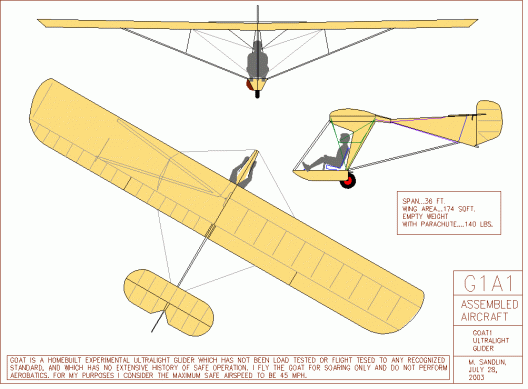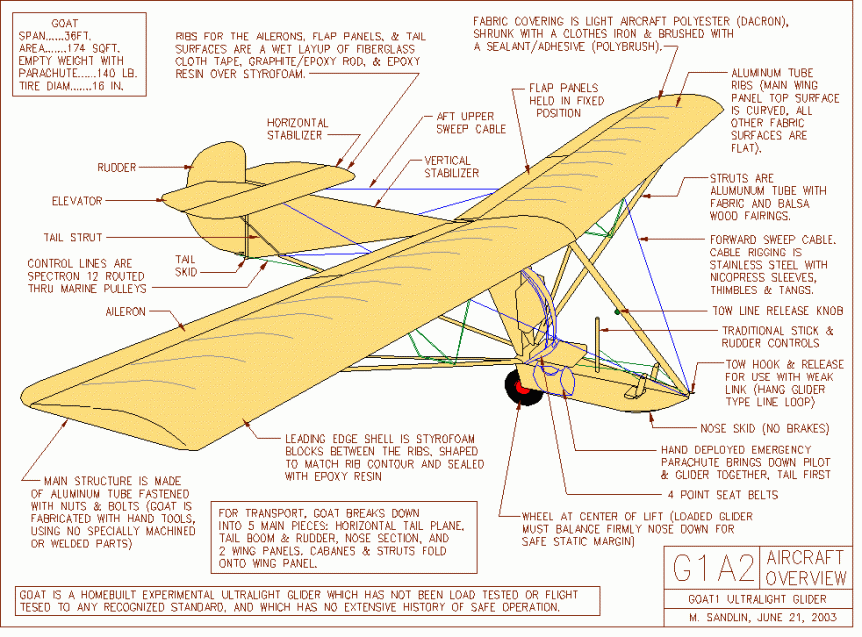Paracas, Peru lies on the South American country’s Pacific coast, halfway between Ecuador and Colombia to the north and Chile to the south. There, Alex Ferrer has built a Super Goat ultralight glider and powered it with a Chinese motor, controller and batteries for electric flight. Since he displays in-flight data on his videos, one can get an appreciation of the small amount of energy required to keep a very light machine like the Mike Sandlin craft in the air.
Sandlin makes plans for his gliders available for free on line. Excellent drawings with high-grade details, they enable a committed craftsman the ability to use simple hand tools to make a glider that one can carry atop a compact car and go flying for as long as one can enjoy. One can choose a Goat monoplane, BUG (Basic Ultralight Glider) biplane, or Bloop powered biplane.

Mike Sandlin’s drawings for the Goat are detailed enough to enable fabrication from metal tubing, fittings and fabric
According to Sandlin’s web site, the gliders share the following characteristics:
- Folding wing design provides a large area wing in a small, light package, allowing transport & assembly by one person.
- Center stick & rudder pedals provide a traditional control system.
- Construction is of aluminum tubing and steel cable covered with a heat shrunk fabric.
Alex Ferrer, a sky-diving and gliding enthusiast in Paracas, built a Goat from plans and used a motor, controller and batties from Dongguan Freerchobby Co.,Ltd to power the beast. The company makes everything from motorized skateboard wheels to large, dual motors that can drive contra-rotating propellers.
The motor, Freerchobby’s 202/80 27 brushless motor with hall sensor controller, is rated at 45 horsepower peak and 25 hp. continuous output. Speed control comes from a Kelly KHB – High Power Opto-Isolated Brushless Motor Controller With Regeneration capabilities – meaning it can feed energy back into the batteries when the motor is windmilling. The 8.9 pound unit complements the low mass of the 6.5-kilogram (14.3-pound) motor. Six CNHL 8000MAH, 22.2V lithium polymer batteries help swing a 49-inch, 30-inch pitch wood propeller.
Battery packs weigh about 2.6 pounds each, or 15.6 pounds total. The 38.8 pound power package seems not too great for the airframe, especially with a light pilot. Pricing for these components should be around $2,500 depending on the controller’s configuration. BUGs and Goats can be built for under $5,000, so these would be sporting machines costing less than some motorcycles or jet skis.
While eVTOLs (electric vertical takeoff and landing) machines dominate the mainstream media, many experimenters are testing the limits at the other end of the flight spectrum. We wish Alex Ferrer the very best and will be re-visiting his YouTube page to check progress. Since Alex has drawn on only six of the 45 reportedly available horsepower from the motor so far, self-launching seems plausible. Such capabilities would open a new range of flight options.


Comments 1
Hi. Alex Ferrer here.
Cool article. You might want to update that the motor only made it to 10Kw before failing. It would not be nice for someone else to buy one thinking that the 45KW power advertised is real.
To be fair, I knew that Chinese manufacturers usually exaggerate on the ratings of their products. I guesstimated that it should handle 20Kw.. (More than enough for the GOAT) so I bought it anyways.. Unfortunately it did not. I guess You get what you pay for.
I’ve been emailing with the manufacturer who suggested it was very strange for it to fail, and offered to send me a new coil.. We are still working on that.
Alex.